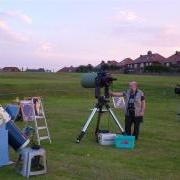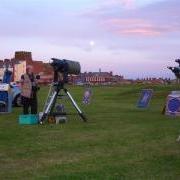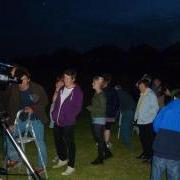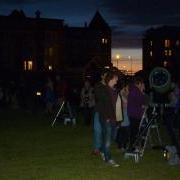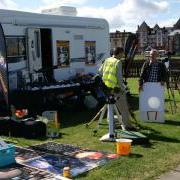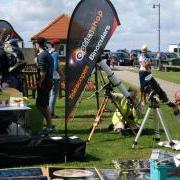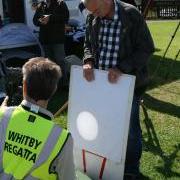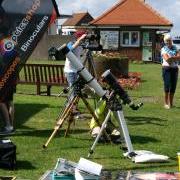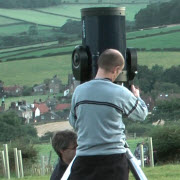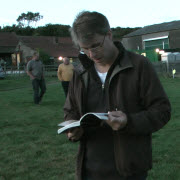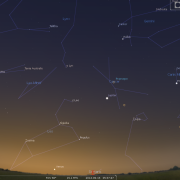Welcome to the WDAS monthly newsletter for September 2014: a digest of the month's latest contributions to our website. Below you'll find Society News, Sky Notes and In-Focus articles printed in full. There's also future events, and trailers for other articles which appear in full on the website - just a click away!
On the website you'll also be able to comment on articles, and if you'd like to play an editorial role in creating new content, just let us know!
If you don't see images in this e-mail, look for a setting in your browser or e-mail reader to display them; and if you have any other problems reading the newsletter please let us know the browser or e-mail program you're using, and we'll see if we can fix it.
Society News
Our Saturday evening star party was a roaring success with quite a large crowd coming along to view amongst other objects: Saturn, the Moon (which was a day off full) and our usual menu of summer sky wonders.
No Perseids were spotted, a little too early, but we did spot the ISS going over;- always a crowd pleaser. By 10:30pm high cloud started to spill in from the west and proceedings came to a close.
As previously mentioned Sunday was a wash out and so an unscheduled (although becoming more regular in recent years) solar party event was held on the Monday afternoon, when it proved even windier than Saturday, so we had to set up in the lea of Marcus’s mobile home.
Given the weather, the phase of the moon and various other uncertainties, Regatta 2014 was reasonably successful, but ohh for some fine settled weather one year, it must be due!
Here are some pictures from Saturday's Star Party, before the storm which put pay to Sunday's planned events.

These Sun Spots were photographed
by Mark in June 2013
Deja Vu, groundhog day, call it what you want, but Regatta weekend was yet again a Woolworth’s pic‘n mix of weather varieties, wind being particularly prominent over the weekend, especially on Saturday and Monday. Sunday was calmer, but like Friday evening and night, the rain lashed down, abated, then lashed down harder, so sodden Sunday was a complete wash out. Having said that a slight improvement in conditions just around the time the Red Arrows showed up allowed them to perform as the cloud base lifted, though not sufficiently for said cloud base to escape the atmosphere completely and allow some form of star party to occur!
Our location for the Solar viewing pitch this year turned out to be adjacent to the paddling pool - near the old trampoline pits. Not quite where we thought we were going to be. But, we were next to Marcus at Grovers Optics, who had heroically come along for all three days of Regatta this year. Access was much easier for loading, so it proved quite a successful location. Better still, there were some nice sunspot groups to observe. The only down side was the gusty wind which played havoc with the poster boards and any items not nailed down on Marcus’s trestle tables.
Here are some pictures of Monday's event. (The usual gazebo is missing for fears of it taking off in the strong wind.)
Members were busy manning the scopes for visitors during the solar event, and didn't get pictures. But Mark and Warren have photographed the sun this recently, jewelled with sun spots.
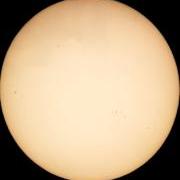 |
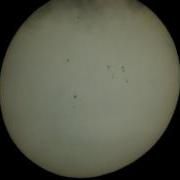 |
|
Sun photographed by Warren on 15-Aug-2014. Click thumbnail for full-size image. |
Sun photographed by Mark from his garden on 08-Jun-2014. Click thumbnail for full-size image. |
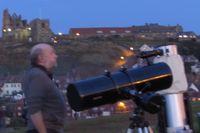
Weather patterns remained unsettled throughout folk week and it wasn’t until Friday 22nd that another event could be held (again unscheduled) Given that it is August, it certainly wasn’t T shirt weather. However skies were clear and with no moon deep sky objects were better in the eyepiece. The following night’s star party again fell foul to a bank of stubborn cloud and bad timing of precipitation, just as we would have been setting up. Still, every cloud has a silver lining, although this one was more pale amber in hue as we sort solace in the Royal Hotel bar.
Sunday night was forecast to be cloudy, so it turned out crystal clear, luckily this had been foreseen and 7 scopes were deployed on the Cook green - a splendid sight, one which drew over quite a number of people to view the Andromeda galaxy, Ring and Dumbbell nebulae, M13, Alberio and the double cluster. It was even nice to see ‘winter’ hove into view as the Pleiades - a seasonal winter treasure, climbed over the NE horizon.
Early Photos from the Hooks House Farm Star Party
(Check the website again soon for a video from the event.)
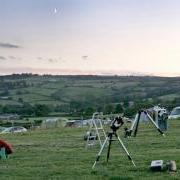 |
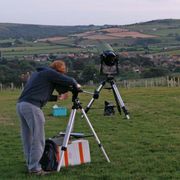 |
|
Setting-up early to catch the new moon. (Photo by Keith) Click thumbnail for full-size image. |
Lee catches the moon. (Photo by Keith) Click thumbnail for full-size image. |
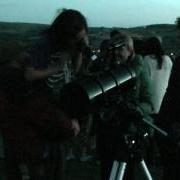 |
|
|
And as night falls, the Star Party begins. (Photo by Andi) Click thumbnail for full-size image. |
Sky Notes
In this month's Sky Notes:
Planetary Skylights
Aahh, September, possibly my favourite month, nights are dark quite early and hopefully not too cold, the Milky Way is at its best from the UK and there’s plenty on offer to tempt the observer, particularly after midmonth when the moon is waning and we have dark skies. September's Full Moon is actually another 'mega moon' event, August's mega moon (the biggest of the year) having been clouded out on that awful Regatta Sunday 10th. So, depending on the weather have camera’s at the ready for a great photo opportunity on Sept 9th (moonrise is around 7:45pm).
September is also the month of the autumnal equinox; equal hours of light and dark again, after which there is more dark in the equation as days grow shorter and the northern hemisphere tilts away from our nearest star. The actual date of the equinox is a little later this year, Sept 23rd - at 3:30am in the morning.

 Planetary wise, Mars and Saturn remain on view, low in the WSW evening twilight sky, but will become increasingly difficult to observe as the month progresses. Mars is trying to keep ahead of the Sun and lies well to the right of Saturn now. The red planet is in conjunction with Antares - chief star in Scorpius on the 29th when the moon is also nearby.
Planetary wise, Mars and Saturn remain on view, low in the WSW evening twilight sky, but will become increasingly difficult to observe as the month progresses. Mars is trying to keep ahead of the Sun and lies well to the right of Saturn now. The red planet is in conjunction with Antares - chief star in Scorpius on the 29th when the moon is also nearby.

 Jupiter and Venus both lie in the dawn sky. Jupiter is quite high up in the east an hour before sunrise and should be easily recognisable, whereas brilliant Venus lies deep in dawn twilight very low to ENE horizon. The moon lies near Jupiter on the 20th.
Jupiter and Venus both lie in the dawn sky. Jupiter is quite high up in the east an hour before sunrise and should be easily recognisable, whereas brilliant Venus lies deep in dawn twilight very low to ENE horizon. The moon lies near Jupiter on the 20th.
 Finally Comet C/2012K1 PANSTARRS may become a good binocular object low in the dawn sky at the start of September. Look for it around 5am on September 3rd across in the east just below/left of zeta Hydra near the head of Hydra.
Finally Comet C/2012K1 PANSTARRS may become a good binocular object low in the dawn sky at the start of September. Look for it around 5am on September 3rd across in the east just below/left of zeta Hydra near the head of Hydra.
Jupiter will reside upper left of the area. Use binoculars to see if you can spot a slightly elongated fuzzy blob. Good hunting!
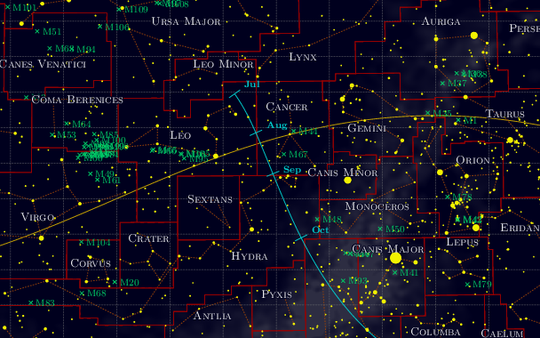
Passage of Comet 2012 K1 Panstarrs though the Sky.
Click image for full-size chart
Meteor Activity

There are no major noteworthy meteor showers in September, however you may spot a few Piscids which have two peaks: the 8th and the 21st. Rates are low, only 5-10 per hour at best. As with all meteor showers early morning viewing will be best. With Full moon on the 9th best chance of spotting some will be the 21st.
September 2014 Sky Charts
Click each image to see a full-size Sky Chart:
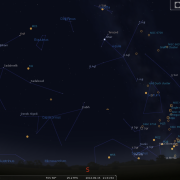 |
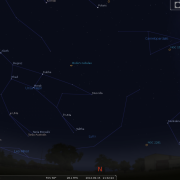 |
| Looking South Mid September-21:30h |
Looking North |
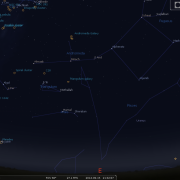 |
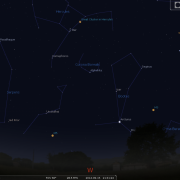 |
| Looking East Mid September -21:30h |
Looking West Mid September-21:30h |
Image Credits:
- Planets: NASA
- Comet 2012 k1 Panstarrs: in-the-sky.org
- Sky Charts: Stellarium Software
In the News
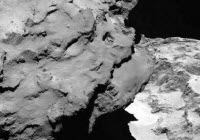 By now, everyone with any interest has seen pictures of the Rosetta Comet Chaser meeting its target: the odd-shaped comet known to its friends as '67P'. But do you know why Rosetta is making a triangular orbit, or that it has a chameleon coma?
By now, everyone with any interest has seen pictures of the Rosetta Comet Chaser meeting its target: the odd-shaped comet known to its friends as '67P'. But do you know why Rosetta is making a triangular orbit, or that it has a chameleon coma?
Physics Professor Ed Copeland of Nottingham University brings you a little more detail than you've seen on the TV news reports in this video...

